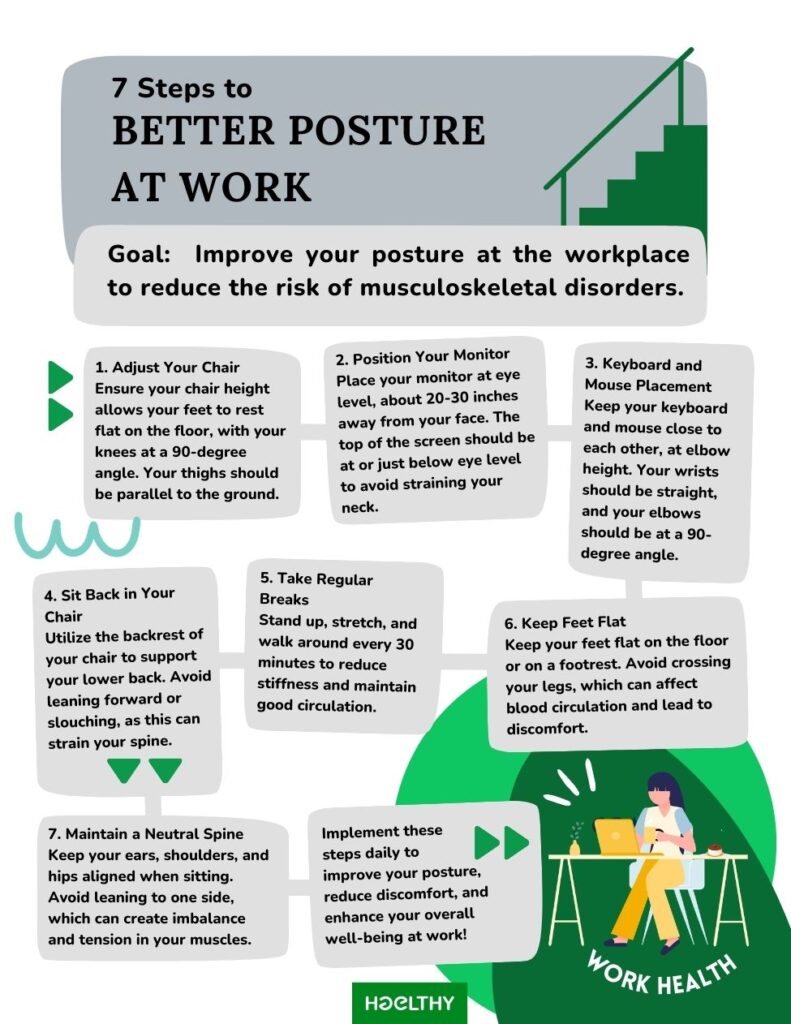In today’s modern workplace, spending long hours at a desk has become the norm. Unfortunately, this can lead to musculoskeletal disorders, discomfort, and fatigue. However, by adopting a few simple habits, you can significantly improve your posture and overall well-being. Here are seven essential steps to achieving better posture at work, all aimed at reducing strain on your body and increasing comfort during your workday.
1. Adjust Your Chair for Optimal Posture
The first step toward better posture at work starts with your chair. Make sure your chair is adjusted to the proper height, allowing your feet to rest flat on the floor with your knees at a 90-degree angle. Your thighs should be parallel to the ground. This setup ensures that your legs are in the most ergonomic position, reducing strain on your lower back and preventing discomfort.
If your feet can’t rest flat on the floor, consider using a footrest to help achieve the desired posture. Sitting too high or too low can place unnecessary stress on your body, so take a moment to find the right balance.
2. Position Your Monitor Correctly
A well-placed monitor is critical for better posture at work. Ideally, your monitor should be positioned at eye level, approximately 20-30 inches away from your face. The top of the screen should be at or just below eye level, allowing you to maintain a neutral head and neck position. This helps prevent neck strain and promotes a more comfortable working experience.
Avoid placing your monitor too low, as this will cause you to hunch forward, leading to poor posture and potential back pain. Ensuring that your screen is in the right position can make a big difference in reducing physical stress on your body throughout the day.
3. Keyboard and Mouse Placement
How you position your keyboard and mouse also affects your posture. For better posture at work, your keyboard and mouse should be close to each other and at elbow height. Your wrists should remain straight, and your elbows should be at a 90-degree angle when using these devices.
Proper keyboard and mouse placement prevent unnecessary strain on your wrists, arms, and shoulders. Ensuring they are within easy reach allows you to maintain a neutral body position, minimizing the risk of developing repetitive strain injuries like carpal tunnel syndrome.
4. Sit Back in Your Chair
To support better posture at work, always sit back in your chair. Utilize the backrest to support your lower back and prevent slouching. Many people tend to lean forward while working, which can cause spine strain over time. Leaning forward consistently places extra pressure on your lower back, eventually leading to discomfort or pain.
By sitting back in your chair and keeping your spine aligned, you can better maintain proper posture, promoting long-term comfort and reducing the likelihood of back issues.
5. Take Regular Breaks
Taking regular breaks is another key component of better posture at work. Standing up, stretching, and walking around every 30 minutes helps reduce stiffness and maintain good circulation. Prolonged sitting in one position can tighten your muscles and lead to discomfort, so it’s essential to give your body time to move and reset.
Regular breaks not only alleviate stiffness but also improve focus and productivity. Even a few minutes of walking or stretching can have a significant positive impact on your physical health and mental clarity.
6. Keep Your Feet Flat
Whether you’re sitting at your desk or taking a break, it’s essential to keep your feet flat on the floor or on a footrest. Crossing your legs or sitting with your feet tucked under you can affect your circulation and lead to discomfort over time. For better posture at work, keeping your feet flat helps maintain a balanced and neutral spine position, reducing strain on your body.
Ensure your chair allows your feet to rest comfortably on the floor or use a footrest if needed. This small adjustment can significantly improve your posture and overall comfort.
7. Maintain a Neutral Spine
Finally, maintaining a neutral spine while sitting is crucial for better posture at work. Keep your ears, shoulders, and hips aligned when sitting, and avoid leaning to one side. Leaning can cause muscle imbalance and lead to tension in your muscles over time.
A neutral spine promotes balanced muscle use, reducing tension and promoting better posture throughout the day. Whether you’re sitting for short bursts or for extended periods, maintaining this alignment will support your overall health.
The Importance of Better Posture at Work
Implementing these steps can lead to significant improvements in your posture and overall well-being. By adjusting your chair, monitor, and workspace, and taking regular breaks, you can alleviate discomfort, reduce the risk of developing musculoskeletal disorders, and improve productivity. Better posture not only supports physical health but also contributes to a more focused and energized workday.
When you consciously follow these steps, you create a healthier work environment for yourself, making it easier to maintain better posture at work long-term.
Conclusion: Take Action Today for Better Posture at Work
Improving your posture at work doesn’t have to be complicated. With these seven simple steps, you can start experiencing the benefits of better posture right away. From adjusting your chair to taking regular breaks, every action contributes to a healthier and more comfortable work environment.
Make these habits part of your daily routine to reduce discomfort, enhance your well-being, and enjoy a more productive workday. By prioritizing better posture at work, you are investing in your long-term health and comfort, ensuring that your workday is as pain-free and efficient as possible.




